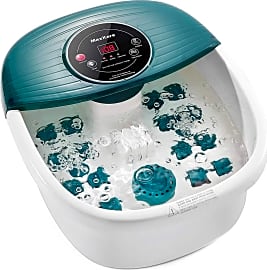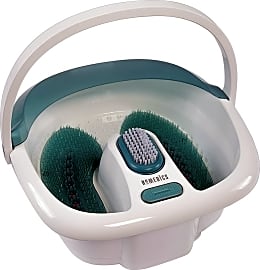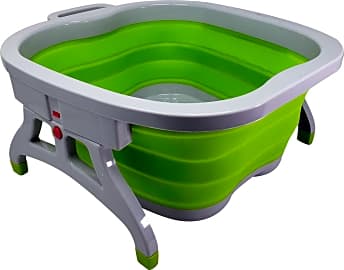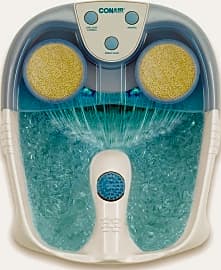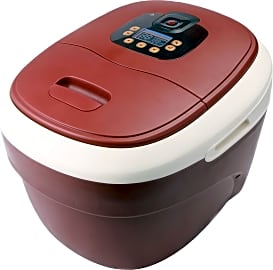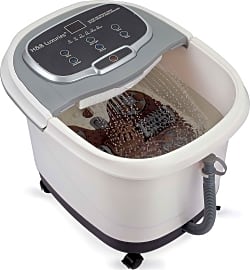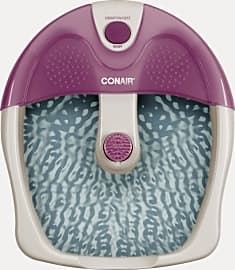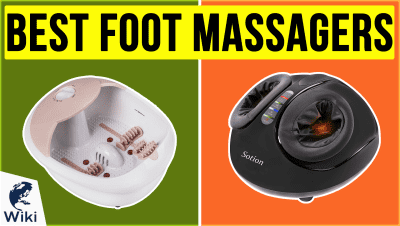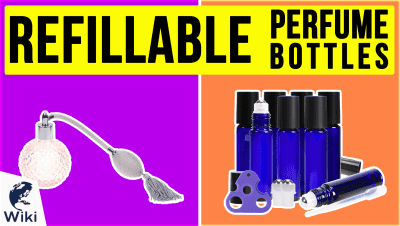The 10 Best Foot Spas

This wiki has been updated 39 times since it was first published in July of 2015. Whether you spend all day on your feet and want some relief, or you are looking for the perfect gift for a hard-working friend, our selection of foot spas includes models that will gently knead tired muscles, soften stubborn calluses, and bring you to a state of relaxation. You'll find models that bubble, vibrate, heat up, spin massaging rollers - and all of the above. When users buy our independently chosen editorial recommendations, we may earn commissions to help fund the Wiki.
Editor's Notes
December 02, 2020:
When shopping for a foot spa, it's important to pay attention to the details because each offers a different constellation of features, including heat, bubbles, vibration, and motorized rollers. Some have inclusions that you may or may not want, from brushes and pumice stones to full pedicure sets.
For this update, we've included a few new models with interesting features, starting with the Conair Waterfall. Its flowing cascade and blue LEDs make it a hit with the young-at-heart. If rollers are your thing, consider the MaxKare Green - it has 16 of them, enough to massage your soles from heel to toe. For a different kind of sole stimulation, the HoMedics Elite 2-in-1 has a soft, seagrass-style bed. Want to go big? The Carepeutic Ozone has just about every feature that exists, plus enough space for the entirety of both of your lower legs.
The Sharper Image Foot and Leg is no longer available, and we removed the WY Foot Bath Barrel because its ratings were no longer on par with its cost. The Comfortology Motorized is also gone because there are similar models with similar ratings available that are less than half its price.
Finally, we've updated the information on several items, including the Revlon Invigorating, the Giantex Massager, and the Kendal All-In-One.
December 03, 2019:
Anyone who stands on their feet all day, from retail workers to nurses, can appreciate these foot baths. We've kept both electric and non-electric versions at this time, but no matter which you choose, be sure to clean and disinfect regularly. Even if you don't share your personal foot bath with anyone else, harmful bacteria can still build up, making regular deep cleansing a good idea.
For those who want all the bells and whistles, we have kept the Kendal All-In-One and added both the Sharper Image Foot and Leg and the Giantex Massager. These heat the water inside and provide other features for relaxation, such as massage action. There's also the Comfortology Motorized, which has plenty of points in its favor but does not have any bubbles. We removed the Ivation Multi-function, though, as it has been shown to leak over the long term.
On the simpler side there are the WY Foot Bath Barrel and the Lee Beauty Professional Foldable, buckets that give you a place for a soak. You might alternate using these with a foot massager for excellent relaxation. We've also kept two models that are electric but do not actually heat, the Conair FB3 and the Revlon Invigorating. They are a step above a plain bucket thanks to vibration and other features, but they do not provide the robust foot spa experience like some of the more full-featured, pricier models.
Special Honors
EuroStyle Portable Hydra Jets Due to its price, the EuroStyle Portable Hydra Jets is probably a bit much for home use, but professionals who wish to perform in-home spa services may find it just right. It was designed with client safety in mind, featuring a system that doesn't have internal piping where bacteria can hide. nailsuperstore.com
Benefits of the Foot Spa
It has even been shown that regular foot baths can help to relieve symptoms of depression and improve emotional health.
Are you someone who enjoys pedicures? Do love a good foot rub? It’s hard to convince people to rub your feet unless they are a paid professional. A foot spa runs on electricity and is intended to provide a relaxing water massage for the feet and sometimes ankles and lower legs.
A foot massage is more than just a relaxing, enjoyable experience. There are pressure points in the feet that correspond to every part of the body. Using reflexology, these parts can be accessed and treated through the bottom of the foot to improve circulation and overall health.
Foot spas can help to improve circulation in the feet and legs and other parts of the body. They relax the muscles and relieve tension in many areas by raising your body temperature. They also enhance white blood cell activity.
Foot baths are often recommended for a variety of medical conditions ranging from mild to moderate. They can help to relieve headaches and pelvic cramps and are even helpful for relieving prostate problems or issues from pelvic inflammatory disease. Have you ever seen the pictures or cartoon drawings of people with colds putting their feet in a warm bath? That’s because foot baths are helpful for relieving symptoms of cold and flu and can help to break up chest congestion.
Foot spas are also amazing for stress relief. If you spend most of your days on your feet, then you carry a lot of stress in your feet, legs, and lower back. A foot bath will help to relieve that tension while also relieving the stress of the day. It has even been shown that regular foot baths can help to relieve symptoms of depression and improve emotional health. It is true that caring for your body extends to caring for your mind.
Foot spas are beneficial for other health problems such as arthritis, insomnia, and even indigestion. You can add essential oils or other aromatic and therapeutic ingredients to the bath to help enhance the effects and create a more relaxing experience.
Think Before You Buy
No matter what foot spa you choose, it is likely going to be powered by electricity and produce heat to create the most relaxing experience possible. Depending on your individual needs, however, not all foot spas are created equal. There are a few things you will need to consider before making your final purchase.
Others have vibrating nodes that add an extra massage element.
First, consider the size of your foot bath. Some are built small and not meant to be filled above the ankles. Still others do not accommodate large foot sizes and can be uncomfortable if your feet are bigger than a size ten. Make sure that the foot spa you choose will be able to cover your feet with water so you can get the full benefits.
Second, consider the available comfort options. Most foot spas use a combination of heated bubbles and jets to produce a relaxing experience. Others have vibrating nodes that add an extra massage element.
Third, find out if your chosen foot spa can be used with Epsom salts, lotions, essential oils, or other things you might want to use to enhance the experience. Some lower quality foot spas cannot be used with these things for fear of clogging the mechanism. High-quality foot spas are compatible with these ingredients.
Finally, find out what kind of controls and settings come with your chosen foot spa. Some only come with one basic setting while others have multiple massage and jet power options. Some have to be controlled by hand using the buttons and knobs on the unit, some have toe-touch controls, and a select few can be controlled using a remote.
A Brief History of Foot Spas
Spas have their origins in ancient times when people began using hot springs and water treatments for medicinal and even spiritual reasons. People often traveled to hot or cold springs in order to treat various ailments. There have been archaeological discoveries dating back to prehistoric eras. Legends in Great Britain gave the early Celtic kings the credit for discovering hot springs in Bath, England.
Once bathing became a regular ritual across developed countries, hot and cold bath treatments for medicinal and therapeutic purposes became regular practice again.
Many ancient cultures used cold and hot springs in their religious ceremonies because they believed that water not only cleansed the body but the spirit as well. These rituals are documented among the ancient Babylonians and Egyptians as well as the Greeks and Romans and even the Native Americans. Purification rituals using water are still prevalent in many religions today including Christianity, Islam, Hinduism, Buddhism, and Judaism.
Despite the beliefs that bathing held physical and spiritual healing properties, it wasn’t until the nineteenth century that it became a regular practice for maintaining proper hygiene. Physicians began to realize that bathing for cleanliness was more beneficial to health than any of the other reasons. It was learned that bathing could help prevent the spread of disease and the risk of developing other illnesses. In 1842, Liverpool, England experienced a cholera epidemic prompting them to promote widespread sanitation rituals. They began to build facilities specifically for bathing and washing clothes.
Once bathing became a regular ritual across developed countries, hot and cold bath treatments for medicinal and therapeutic purposes became regular practice again. Spas were established across the United States and Europe for people to pay for massages, spa baths, and other relaxing experiences. They added beauty and pampering treatments designed to enhance relaxation, and some even offer full-service gyms to promote physical fitness as well as relaxation.
These practices for cleanliness, physical and mental health, and beauty have resulted in the development of home foot spas so people can create their own relaxing foot massages and treatments in the comfort of their own homes without incurring the high costs of an expensive spa.


